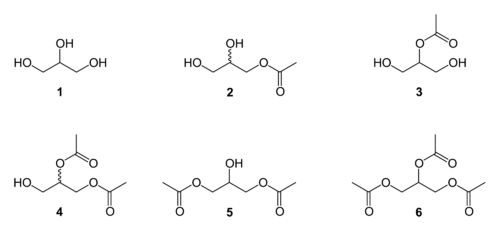Glycerine acetate
 R = H or CH3C(=O) | |
| Names | |
|---|---|
| Other names
Glycerin acetate; Glycerol acetate | |
| Identifiers | |
| ECHA InfoCard | 100.014.216 |
| Properties | |
| Variable | |
| Molar mass | Variable |
Except where otherwise noted, data are given for materials in their standard state (at 25 °C [77 °F], 100 kPa). | |
| Infobox references | |
Glycerine acetate is a mixture of esters produced from the esterification of glycerol (1) with acetic acid. Multiple products can be produced from this reaction; these include the monoacetylglycerols (MAG, 2 and 3), diacetylglycerols (DAG, 4 and 5), and triacetalglycerol (TAG, triacetin, 6).

DAG and TAG can be used as fuel additives for improving the cold and viscosity properties of biodiesel or the antiknocking properties of gasoline.[1]
Notes
- ↑ J. A. Melero; R. vanGrieken; G. Morales; M. Paniagua (2007). "Acidic Mesoporous Silica for the Acetylation of Glycerol: Synthesis of Bioadditives to Petrol Fuel". Energy Fuels. 21 (3): 1782–1791. doi:10.1021/ef060647q.
This article is issued from
Wikipedia.
The text is licensed under Creative Commons - Attribution - Sharealike.
Additional terms may apply for the media files.